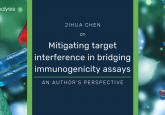GCC ICH M10: thoughts from Rafiq Islam

Rafiq Islam is the Senior Director of Bioanalytical Services at Celerion Inc. (NE, USA). In his current role, he is responsible for the scientific and operational leadership of both small- and large-molecule bioanalysis, which includes the development and validation of bioanalytical methods, and the execution of sample analysis to support pharmacokinetic, immunogenicity, bioequivalence and biosimilar studies.
He also serves as the chairman of the scientific advisory board for Somru Bioscience Inc. He advises Somru on the development of FDA BMV compliant bioanalytical kits (i.e. pharmacokinetic, anti-drug antibody, biomarker etc.) to support biosimilar and biologics development.
Previously, he served as the Scientific Director for Biopharma Services at EMD Millipore (MO, USA). He held similar positions as the head of a bioanalytical department at Covance Inc. (AZ, USA) and Huntingdon Life Sciences (NJ, USA). He also held several positions of increasing responsibility with Curagen Corporation. He has over 18 years of biotechnology and CRO industry experience.
1 Why was there a need for the ICH M10 guidance, when there are already BMV guidance available?
Currently, there are numerous agencies providing regulatory guidance (such as the US FDA, EMA, Japanese MHLW, Brazil’s ANVISA, etc.) that applies to the area of regulatory bioanalysis. In each case, this guidance is country specific or region specific, full of nuances and in some cases outright contradictions. This poses challenges for global CROs operating in multiple jurisdictions and sponsors who want to bring their drug to global markets in a cost-effective manner. The evolving global nature of drug development requires harmonized global regulatory guidelines. ICH M10 is a significant step in the right direction towards harmonizing existing and emerging bioanalytical guidance to create a consensus document that can be applied globally. The harmonization of bioanalytical guidance can reduce the time and cost of the drug development process while maintaining one global standard for quality and regulatory expectations can ultimately benefit patients globally.
2 From a CRO perspective, was the draft guidance what you expected from a harmonized consensus guidance?
The guidance document is mostly in line with the industry expectation with a few exceptions. There are some opportunities to improve the guidance by incorporating science and data driven recommendations. I hope that the feedback provided by the GCC in this article and other feedback from industry organizations will help improve the quality of the final guidance.
3 Are there any disadvantages of such a collective consensus guidance, when used among different laboratories (e.g., Pharma, CROs, vendors etc.)?
Overall, the guidance document is well written and contains very few surprises. Many of the practices adopted in this document have been in discussion for decades and the authors of the guidance were able to incorporate, in most cases, industry best practices. This document provides a harmonized framework for conducting regulatory bioanalysis that applies globally, improving consistency of data generated across pharma, biotech and CROs. However, it should be noted that the guidance document mostly addresses only pharmacokinetic assays to support small molecule drugs and large molecule drugs such as protein and antibody. It does not address biomarker assays, which are one of fastest growing type of assays in the area of regulatory bioanalysis. It has minimal relevance to the bioanalysis of gene therapy products, cell therapy, etc. or the bioanalytical techniques such as immunoaffinity-LC-MS/MS, qPCR or flow cytometry.
4 How easily can CRO’s adapt to implementing the ICH M10 guidance, while maintaining outsourcing standards?
Like all guidance documents, there is always some room for interpretation. The Global CRO Council and the Workshop on Recent Bioanalysis (WRIB) were good forums for discussion of the guidance and to hash out any differences in interpretation with industry colleagues and regulators. From historical standards, this document is well written and recommendations are specific. Celerion, for example, continuously track regulatory guidance in anticipation of potential changes and believe we will be able to adopt this guidance with moderate effort. This guidance is a significant step forward in establishing a global harmonized approach to regulated bioanalysis.




